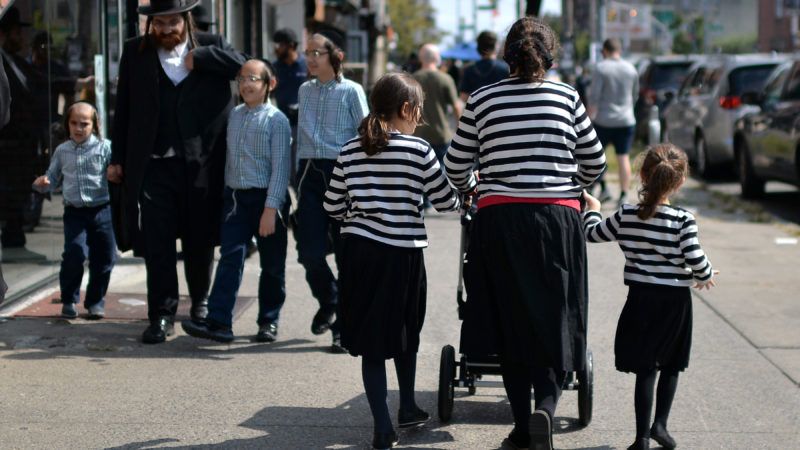Orthodox Jews Say They're Being Targeted by New NYC Lockdowns
The newest lockdown, which explicitly targets religious gatherings, seems likely to further skepticism of public health directives.

A group of Orthodox Jewish men gathered Tuesday evening in Brooklyn, burning masks to protest the newest iteration of New York's pandemic lockdown. Their anger is reasonable, because the newest lockdown—which disproportionately affects the city's Jewish community and explicitly targets religious gatherings—is not. It is deeply stupid and unfair, exactly the sort of easily avoidable government overreach that makes even well-intended people doing their best to mitigate the spread of COVID-19 understandably skeptical of public health directives.
At issue is New York Gov. Andrew Cuomo's "Cluster Action Initiative," implemented at the request of New York City Mayor Bill de Blasio and announced several hours before the fire. The program identifies infection clusters—areas with positive test rates above 3 percent for seven consecutive days—and imposes a graduated system of restrictions until the rate drops.
In the strictest rule set, the "red zone," schools along with businesses deemed nonessential are closed. In-person dining is banned. Houses of worship are limited to gatherings of 25 percent capacity or 10 people, whichever is smaller, with $15,000 fines for violations. In fact, as Cuomo said Tuesday in a line sure to appear in forthcoming First Amendment litigation, religious gatherings are the main target: "The new rules are most impactful on houses of worship," he declared. "This virus is not coming from nonessential business." (Then why, one wonders, are those businesses required to close?)
From there Cuomo pivoted to claiming the support of New York City's Orthodox Jewish leaders, because in some of these neighborhoods, "houses of worship" basically means synagogues, and "private schools" means Hebrew schools and yeshivas. The lockdown arrived in the middle of Sukkot, a week-long holiday celebrated, as holidays generally are, with gatherings—including gatherings where a minimum of 11 people are needed to guarantee a required quorum.
Cuomo, who is not himself Jewish, tried to buttress his argument by citing Jewish teaching. "The Torah speaks about how certain religious obligations can be excused if you are going to save a life….That's what this is," he said. "I felt very good about my conversation with the Orthodox community."
Suffice it to say the Orthodox community does not feel equally good. A group of rabbis said their conversation with the governor was "a one-way monologue" in which Cuomo never mentioned his strict assembly rule. A statement from four Jewish city council members slammed the "draconian" plan as "a scientifically and constitutionally questionable shutdown" enacted after a "duplicitous bait-and-switch." Per their account, the governor obtained community buy-in by promising synagogues could operate at 50 percent capacity with no numerical cap. For a synagogue large enough to seat hundreds or thousands, that's a guideline very far from the 10-person limit ultimately mandated. (And if 25 percent capacity is safe in a small building, it's surely safe in a large building too.)
On its surface, the 3 percent positive rate is a religiously neutral condition. The reason Jewish communities are more likely to be affected, Cuomo and de Blasio can argue, is simply that they have a higher transmission rate, due to lax mask use and social distancing habits. That may be true, but neither the math nor the politics of this situation is that simple.
New York City's positive rate peaked at nearly 70 percent in early April, at which point fewer than 8,000 people were tested per day. Now the city's daily testing average is over 30,000, and the city-wide positive rate is under 2 percent, as it has been for months, though the city has moved into the fourth phase of its reopening plan (which allows religious gatherings at 50 percent capacity outside cluster neighborhoods). The clusters have positive rates between 3 and 7 percent. That's worse than the rest of the city, but still dramatically better than the spring surge, when lockdown was implemented to "flatten the curve" and prevent hospital overload. The city's COVID-19 hospitalizations hit 12,000 in the spring; now the total is under 400, clusters included. There is no comparable overload risk.
Moreover, it's not as if these neighborhoods are impermeably isolated from the rest of the city. Residents work, shop, study, and worship outside lockdown boundaries. "Nonessential" stores just past the edge of the red zones will do a lively (perhaps crowded!) business while their competitors a few blocks away are compelled to close.
But education and worship can't work around Cuomo's edict so easily. And these rules come after months of discord. There was de Blasio's unfortunate April tweet singling out "the Jewish community" for holding large gatherings, and his dismissal of a question from a reporter for an ultra-Orthodox outlet about why large protests were permitted while small religious gatherings weren't. Just this Monday, Cuomo's office used a 14-year-old photo of a rabbi's packed funeral to illustrate the governor's remarks about COVID-19. Even before the cluster plan, the "community [felt] they're being singled out and there's some element of anti-Semitism," Jewish Voice publisher David Ben Hooren said Monday. "Tensions are running high."
Those tensions are bad for public health. They may make people less likely to get tested if they have relatively mild symptoms. The Forward reports that this may already be happening: Much as the drug war deters people from seeking addiction treatment for fear of legal consequences, people are scared their positive test results will give the government a reason to shut down their schools and houses of worship.
A policy that amounts to punishing positive tests will produce fewer positives, but not necessarily fewer infections. It might well make the pandemic worse, as untested, infected people go about their normal business and public anger over unreasonable restrictions grows into public rejection of practices, such as mask use, that actually help. That face mask fire may be a portent of unintended consequences to come.



Show Comments (145)